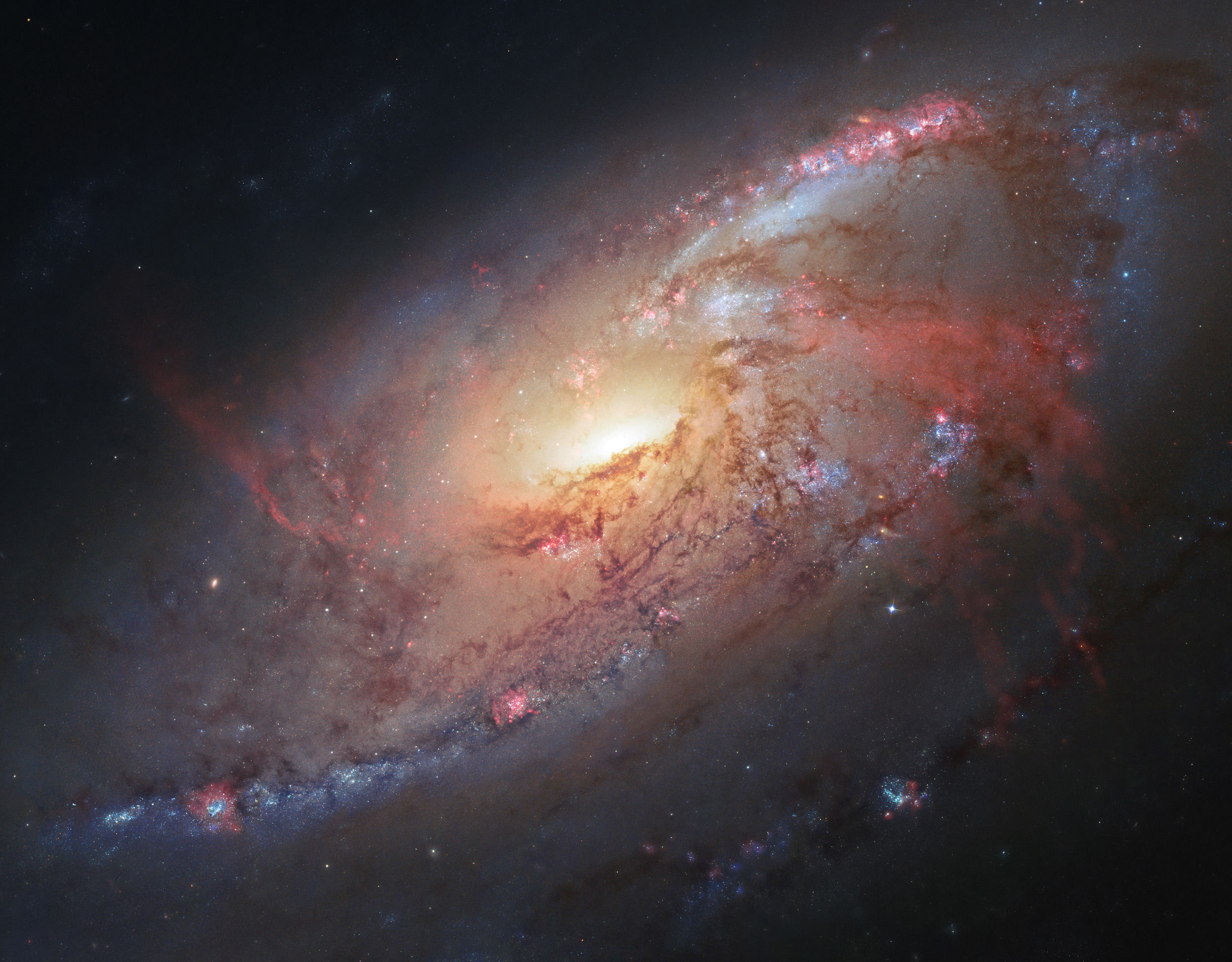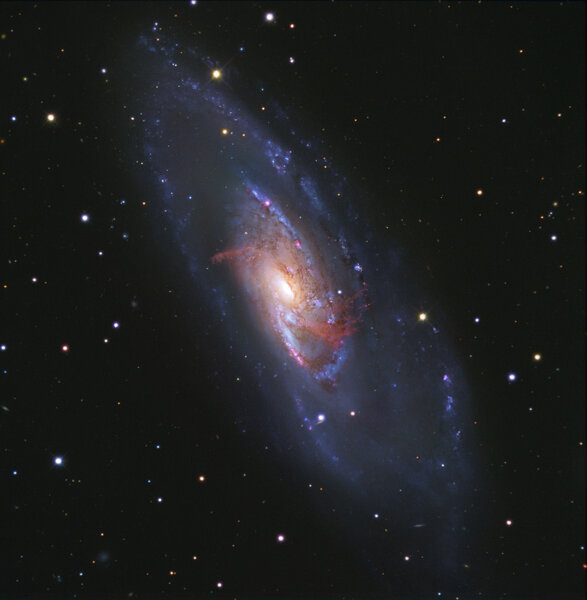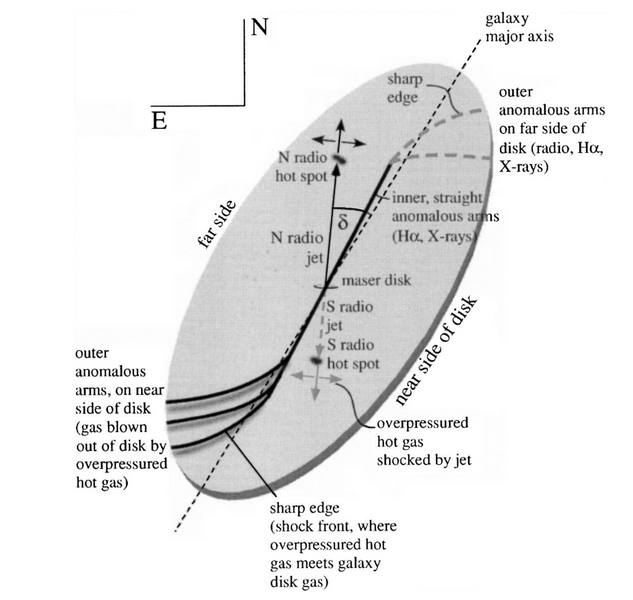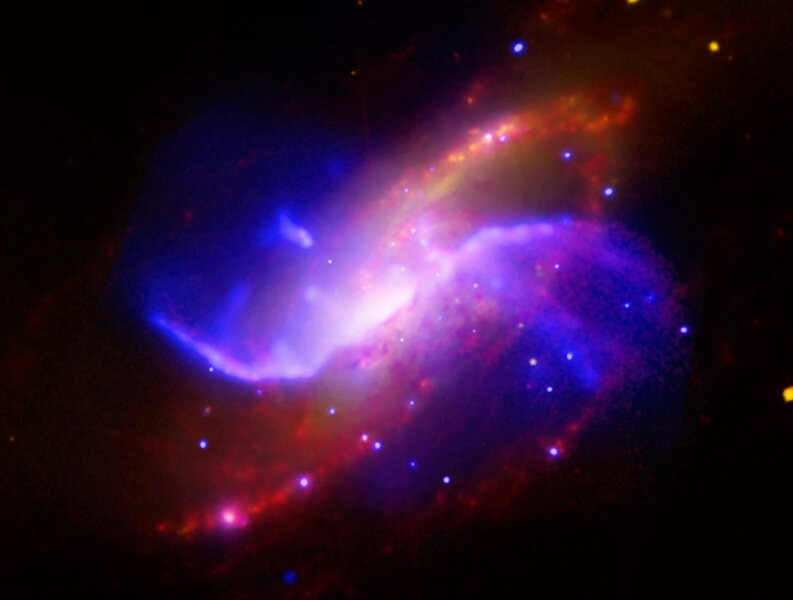Create a free profile to get unlimited access to exclusive videos, sweepstakes, and more!
Thanks to a huge black hole, this galaxy grew an extra pair of arms

One of my favorite kinds of observations of astronomical objects is one that makes me think, “Oh hey, I wonder what’s going on there!” It happens a lot even when you’ve been doing astronomy for a long time. Maybe more; after a while you know enough to spot the weird stuff, the things that don’t fit.
A really good example of this is M106 (also called NGC 4258), a relatively nearby spiral galaxy just about 23 million light years away. At first glance it just looks like a regular galaxy, tipped pretty far over so that it looks elongated (as the circular rim of a drinking glass looks like an ellipse if seen at an angle). But then you look again, and you see that yeah, it’s weird.
First, here’s a spectacular image of M106 created by astrophotographer Robert Gendler, who made it by using observations from Hubble Space Telescope, a 0.9 meter ‘scope at West Mountain Observatory in Utah, and his own telescope:
That is really gorgeous. The wide field of view is courtesy the two smaller ’scopes, and the detail in the center is from Hubble (Gendler is a master at merging images like these, which is extremely difficult to do). The blue spiral arms are obvious, where stars are being born. The most massive of these stars are very hot and blue, accentuating the structure.
The core of the galaxy is bright and more yellow; stars haven’t been born there in a long time, so the massive blue stars (which only live a few million years) are all gone, leaving being the lower mass, redder stars.
But… what are those weird red spirals coming out from the center? Are those spiral arms, too?
It turns out nope, they’re not. They’re called the anomalous arms, and they’re a completely different structure caused by a completely different phenomenon! And, as in so many cases where strange things are afoot, a black hole is to blame.
At the center of every big galaxy is a supermassive black hole. And that word means just what it says: In the case of M106, the black hole at its heart is 40 million times the mass of our Sun! In case you’re curious, that’s ten times the heft of the one in the center of our galaxy, the Milky Way. It’s a biggun.
Also unlike our own black hole, which is quiet right now, the one in M106 is actively feeding. You can’t see it on this scale, but a disk of material is swirling around it, a pileup of gas outside the hole like water going down the drain. As it revolves around the hole, the magnetic field locked into that material winds up like a corkscrew, and is so powerful it can pull stuff out from the disk and launch it away from the galactic center at high speed, focused into two beams (astronomers call these jets).
This is pretty common with galaxies like this, called active galaxies. What’s odd here is that the jets aren’t aligned with the galaxy’s axis! Usually the accretion disk of stuff outside the black hole is aligned with the disk of the galaxy around it. But in M106, for some reason, the disk is tilted by about 60°, which means the jets are only aimed about 30° above the plane of the disk! And that changes everything.
It took a while for astronomers to understand what’s happening here, but a picture is emerging on how this works. The jets blast outward from the black hole and into the plane of the galaxy. They slam into gas there, accelerating it to high speed. After a few hundred light years this stuff is punched out of the disk, like a geyser aimed at a low angle. It then moves outward, above and below the disk, hitting the much thinner gas outside the galaxy. This less dense stuff then gets heated up by the material barraging it, too.
So what you have now is like a bright, hot fountain sticking out of the galaxy at a low angle over the disk. This stuff then expands rapidly, and some of it falls back down onto the galaxy disk. This is seen as the straight inner part of the anomalous arms, which is disk gas heated by this incoming material. The gas is dense and held pretty tightly by the galaxy’s gravity, so the structure is persistent.
The curve you see at the tips of these arms that make them look so much like spirals is actually gas farther out from the center that has a lower density. Because it’s farther out, it’s also not held on as tightly as the gas closer to the center, so it’s able to puff up and be driven out of the disk.
The reason the anomalous arms are red is that they’re mostly hydrogen gas. When that stuff gets tossed around and heated like this it glows, emitting light at a very specific wavelength called H-alpha. I describe how this works in detail in an article I wrote about gas clouds that glow this way.
I know, this is pretty complicated. I had to read the journal paper describing it a couple of times to wrap my head around it, if that helps. The point is: Jets from the black hole are stirring up the gas in M106, and that stuff gets hot and creates those two structures that look like spiral arms but aren’t.
But then, that’s part of the lesson here too. Sometimes when you see something odd in a galaxy, it’s easy to figure out what’s what. Sometimes it ain’t. This explanation took observations from multiple telescopes at multiple wavelengths (X-ray and radio observatories played a big role, too) to build up enough information for the astronomers to sleuth it out.
And that’s a good analogy. When it comes to things like this astronomers are cosmic detectives, seeking out clues and putting them together into a coherent picture. It doesn’t always work — there are plenty of mysteries left to uncover — but sometimes it does. M106 looks like one of those cases where, after a lot of work, we do understand the big picture, but of course there are always lots of details left to figure out too.
No mystery is ever really completely solved. And good thing, too. Where’s the fun in that?






























